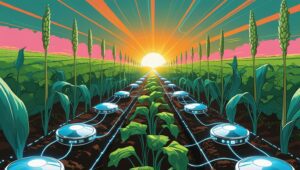IoT Sensors Propel Climate Data Innovation Now

Climate change is all around us. Storms are stronger, summers are hotter, and ice is melting faster than ever. How do we keep up with these changes? That’s where IoT sensors come in. These tiny devices are changing how we track the environment. They collect data in real time, helping scientists and communities fight climate change. This blog post explores how IoT sensors work, why they’re a game-changer, and what challenges they face. Let’s dive in!
What Are IoT Sensors?
IoT sensors are small gadgets that measure things like temperature, air quality, or humidity. They connect to the internet, sending data instantly to computers or phones. Imagine a tiny weather station in your backyard, constantly checking the air and sending updates. That’s an IoT sensor at work! These devices are cheap, easy to use, and can be placed almost anywhere—from city streets to deep forests.
How Do They Help with Climate Data?
IoT sensors collect information about the environment every second. This real-time data is key to understanding climate change. For example, they can measure carbon dioxide levels in a city or track rainfall in a forest. Scientists use this data to predict weather patterns or warn about disasters like floods. Unlike old-school tools that check data once a day, IoT sensors never stop, giving us a clearer picture of our planet.
Why IoT Sensors Are a Big Deal
IoT sensors are shaking things up because they’re fast, affordable, and powerful. Here’s why they matter for climate data innovation:
- Real-Time Updates: They send data instantly, so we can act quickly if something’s wrong, like a sudden rise in pollution.
- Wide Coverage: You can place IoT sensors in hard-to-reach spots, like oceans or mountains, to get data from everywhere.
- Cost-Effective: These sensors are cheaper than traditional equipment, so more people can use them, even in poorer areas.
- Smart Analysis: IoT sensors work with computers to spot trends, like rising temperatures, helping us plan better.
In short, IoT sensors make climate data easier to get and use. They’re helping everyone from farmers to city planners tackle climate change head-on.
Where Are IoT Sensors Used?
IoT sensors are popping up everywhere to track climate change. Let’s look at a few places they’re making a difference.
Cities and Air Quality
In big cities, air pollution is a huge problem. IoT sensors measure harmful gases like nitrogen dioxide or tiny dust particles in the air. For example, some cities use these sensors to check air quality every hour. This helps leaders make rules to cut pollution, keeping people healthier. IoT sensors give us the data we need to breathe easier!
Farms and Forests
Farmers use IoT sensors to check soil and weather conditions. This helps them save water and grow crops even when the climate is unpredictable. In forests, sensors watch for signs of fires or illegal tree-cutting. By catching these issues early, IoT sensors protect nature and help us adapt to changing conditions.
Oceans and Rivers
The oceans are warming up, and IoT sensors are helping us understand how fast. Floating sensors, called buoys, track water temperature and acidity. This data shows how climate change affects marine life. On rivers, sensors warn about rising water levels, helping communities prepare for floods.

Challenges IoT Sensors Face
IoT sensors are amazing, but they’re not perfect. There are some hurdles to overcome to make them even better for climate data tracking.
Keeping Data Safe
Since IoT sensors send data over the internet, hackers could try to steal it. We need strong security to keep this information safe. Scientists are working on better ways to lock down sensor data, like using special codes.
Powering Sensors
Many IoT sensors run on batteries, which can die out in remote places like forests or oceans. Replacing them is tough! New ideas, like solar-powered sensors, are helping, but we need more solutions to keep sensors running longer.
Connecting Everything
Not all IoT sensors work well together. Some use different systems, making it hard to combine their data. Standardizing how sensors talk to each other is a big goal for the future.
What’s Next for IoT Sensors?
The future of IoT sensors is exciting! New technologies, like super-fast 6G networks, will let sensors send data even quicker. Artificial intelligence can team up with IoT sensors to predict climate changes better. For example, computers could analyze sensor data to warn about storms days in advance. Plus, new sensors might run on energy from the sun or wind, making them greener.
Conclusion
IoT sensors are changing how we fight climate change. They give us real-time data to track air, water, and land conditions. From cities to oceans, these tiny devices are helping us understand our planet better. But there’s more to learn about making them safer, longer-lasting, and easier to use. Want to dive deeper into how IoT sensors are shaping climate science? Check out our full research paper for all the details!
[Read the Full Research Paper]




